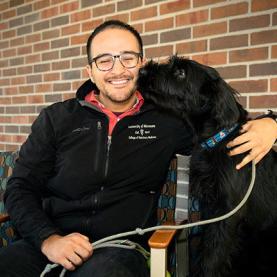“I saw it as an opportunity to benefit the veterinary dental curriculum. It seems to be a big hit."
In their second year, University of Minnesota veterinary students are introduced to dental basics. And while for most students practice makes perfect, Michael Congiusta’s (Brooklyn, NY) experience left him feeling a step was missing between class and lab. So he created models of the teeth of canines so students could practice basic dental skills.
Before any of their labs this semester, many second-year students were able to practice on Congiusta’s models. He applies a synthetic mixture to the plastic molds so students can practice and familiarize themselves with what to expect in lab.
“My vision was to provide each student with their own model so they can take it home,” he says. “I got a lot of great feedback from the students who tried it.”
The U of M School of Dentistry was also encouraging. “I told them about my idea and they were very accommodating with helping me out and everybody has been really supportive in what I am trying to accomplish,” says Congiusta.
Recently, Congiusta’s models took home the grand prize at “The Idea”—a national innovation competition for veterinary students. With the prize came a $10,000 award, which Congiusta has invested in further developing his models. Previously, he was building them in his bedroom. Now he has launched Veterinary Active Learning, LLC, and is waiting for mock-ups of his models from a medical device company.
Congiusta, whose parents are both dentists, has a passion for veterinary education, innovation, and small animal oral health. Yet his desire to improve veterinary dental care extends beyond veterinary school.
“Any proceeds I make from these canine models, I would reinvest into creating a cat model and then a horse model,” he says. In addition, he is looking to create educational programs and tools for students, including a software program.
“I just think it is important for students to learn [these] skills,” says Congiusta, “and constantly refresh their education throughout their career.”
-------
This story appeared in its original form at College of Veterinary Medicine news.

